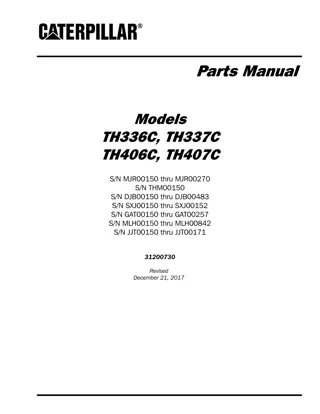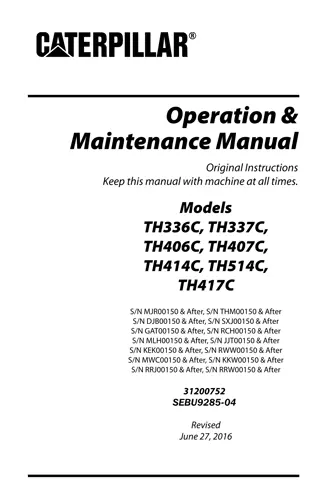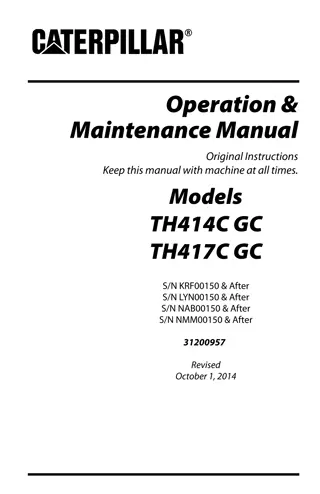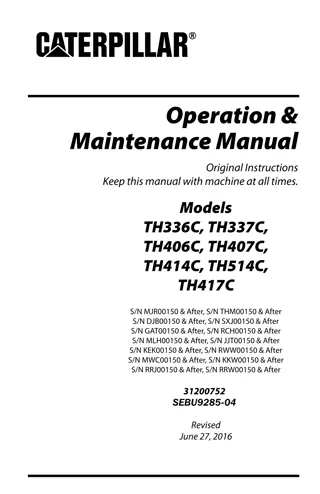
Caterpillar Cat TH255C Telehandler Operator Manual Instant Download
Please open the website below to get the complete manualnn//
Download Presentation

Please find below an Image/Link to download the presentation.
The content on the website is provided AS IS for your information and personal use only. It may not be sold, licensed, or shared on other websites without obtaining consent from the author. Download presentation by click this link. If you encounter any issues during the download, it is possible that the publisher has removed the file from their server.
E N D
Presentation Transcript
Operation & Maintenance Manual Original Instructions Keep this manual with machine at all times. Model TH255C SN JK200150 to Present SN JK300150 to Present 31200746 SEBU9291-01 Revised June 22, 2016
Table of Contents Table of Contents TABLE OF CONTENTS Revision Log Read This First Operator Qualifications...........................................................................b Modifications...............................................................................................b Other Publications Available.................................................................d Table of Contents Section 1 - General Safety Practices 1.1 Hazard Classification System ....................................................................1-1 Safety Alert System and Safety Signal Words...............................1-1 1.2 General Precautions.....................................................................................1-1 1.3 Operation Safety............................................................................................1-2 Electrical Hazards....................................................................................1-2 Tip Over Hazard.......................................................................................1-4 Travel Hazard............................................................................................1-7 Load Falling Hazard ...............................................................................1-8 Lifting Personnel.....................................................................................1-9 Driving Hazards on Slopes................................................................1-10 Pinch Points and Crush Hazards.....................................................1-11 Fall Hazard..............................................................................................1-13 Chemical Hazards................................................................................1-14 1.4 Product Link (if equipped)......................................................................1-15 Federal Communications Commission (FCC) Information for Users..........................................................................1-15 Section 2- Pre-Operation and Inspection 2.1 Pre-Operation Check and Inspection.....................................................2-1 2.2 Safety Decals...................................................................................................2-4 ANSI (if equipped)...................................................................................2-4 ISO (CE & AUS) (ANSI, if equipped)...................................................2-7 2.3 Walk-Around Inspection..........................................................................2-10 2.4 Warm-Up and Operational Checks......................................................2-12 Warm-Up Check...................................................................................2-12 Operational Check...............................................................................2-12 2.5 Operator Cab................................................................................................2-13 2.6 Windows........................................................................................................2-14 Cab Door Window (if equipped)....................................................2-14 Rear Window.........................................................................................2-15 31200746 i
Table of Contents Section 3- Controls and Indicators 3.1 General..............................................................................................................3-1 3.2 Controls............................................................................................................3-2 Park Brake..................................................................................................3-4 Parking Procedure..................................................................................3-5 Ignition.......................................................................................................3-6 Transmission Control Lever................................................................3-7 Load Stability Indicator - LSI (CE & AUS).........................................3-8 LSI Override Switch (CE & AUS).......................................................3-10 Steering Column Adjuster (if equipped).....................................3-11 Instrument Panel.................................................................................3-12 Joystick....................................................................................................3-14 Right Hand Console............................................................................3-16 Accessory Control Lever (if equipped).........................................3-18 Reversing Fan (if equipped).............................................................3-19 3.3 Steer Modes.................................................................................................3-20 Steer Mode Change............................................................................3-20 3.4 Operator Seat..............................................................................................3-21 Operator Presence (CE & AUS)........................................................3-21 Adjustments..........................................................................................3-22 Seat Belt..................................................................................................3-23 3.5 Boom Angle and Extension Indicators...............................................3-24 3.6 Reverse Sensing System..........................................................................3-25 Section 4- Operation 4.1 Engine...............................................................................................................4-1 Starting the Engine................................................................................4-1 Cold Weather Starting..........................................................................4-2 Battery Boosted Starting......................................................................4-3 Normal Engine Operation...................................................................4-4 Shut-Down Procedure..........................................................................4-4 4.2 Operating with a Non-Suspended Load...............................................4-5 Lift Load Safely........................................................................................4-5 Before Picking Up a Load.....................................................................4-5 Transporting a Load ..............................................................................4-6 Leveling Procedure................................................................................4-6 Placing a Load..........................................................................................4-7 Disengaging a Load...............................................................................4-7 ii 31200746
https://www.ebooklibonline.com Hello dear friend! Thank you very much for reading. Enter the link into your browser. The full manual is available for immediate download. https://www.ebooklibonline.com
Table of Contents Operating with a Suspended Load (ANSI & CE)..................................4-8 Lift Load Safely.........................................................................................4-8 Picking Up a Suspended Load............................................................4-8 Transporting a Suspended Load.......................................................4-9 Leveling Procedure................................................................................4-9 Placing a Suspended Load...............................................................4-10 Disengaging a Suspended Load ....................................................4-10 Road Operation (CE)..................................................................................4-11 Loading and Securing for Transport ...................................................4-12 Tiedown...................................................................................................4-12 Lifting.......................................................................................................4-13 Section 5- Attachments and Hitches 5.1 Approved Attachments...............................................................................5-1 5.2 Unapproved Attachments.........................................................................5-1 5.3 JLG Supplied Attachments.........................................................................5-2 5.4 Telehandler/Attachment/Fork Capacity...............................................5-4 5.5 Use of the Load Chart..................................................................................5-5 Capacity Indicator Locations..............................................................5-5 Sample Load Chart (ANSI & CE) .........................................................5-6 Sample Load Chart (AUS).....................................................................5-7 Example......................................................................................................5-8 5.6 Attachment Installation..............................................................................5-9 Standard Quick Coupler.......................................................................5-9 Universal Quick Coupler (UQC).......................................................5-12 5.7 Hydraulic Operated Attachment..........................................................5-14 5.8 Adjusting/Moving Forks..........................................................................5-15 5.9 Attachment Operation.............................................................................5-16 Carriage with Forks .............................................................................5-18 Fork Mounted Hook (ANSI & CE)....................................................5-19 Rotate/Side Tilt Carriage...................................................................5-20 Side Shift Carriage...............................................................................5-22 Bucket......................................................................................................5-24 Multipurpose Bucket..........................................................................5-26 Grapple Bucket and Muck Fork Grapple......................................5-28 Material Handling Arm (ANSI & CE)...............................................5-30 Coupler Mounted Hook.....................................................................5-31 5.10 Hitches............................................................................................................5-32 Retrieval Hitch.......................................................................................5-32 Adjustable Auto Hitch........................................................................5-33 Pin Hitch - CUNA C...............................................................................5-34 EEC Manual Pin Hitch.........................................................................5-35 4.3 4.4 4.5 31200746 iii
Table of Contents Section 6- Emergency Procedures 6.1 Towing a Disabled Product.......................................................................6-1 Moving Short Distances.......................................................................6-1 Moving Longer Distances....................................................................6-1 6.2 Emergency Lowering of Boom.................................................................6-2 6.3 Emergency Exit from Enclosed Cab........................................................6-3 Inside Cab..................................................................................................6-3 Outside Cab (if equipped)...................................................................6-3 Section 7- Lubrication and Maintenance 7.1 Introduction....................................................................................................7-1 Clothing and Safety Gear.....................................................................7-1 7.2 General Maintenance Instructions..........................................................7-2 7.3 Service and Maintenance Schedule.......................................................7-3 10 & 1st 50 & 50 Hour Maintenance Schedule.............................7-3 1st 250, 250 & 500 Hour Maintenance Schedule ........................7-4 1000 & 1500 Hour Maintenance Schedule....................................7-5 7.4 Lubrication Schedules.................................................................................7-6 250 Hour Lubrication Schedule.........................................................7-6 7.5 Operator Maintenance Instructions.......................................................7-8 Fuel System...............................................................................................7-8 Engine Oil...............................................................................................7-10 Hydraulic Oil..........................................................................................7-11 Tires..........................................................................................................7-12 Air Intake System.................................................................................7-14 Engine Cooling System.....................................................................7-16 Battery.....................................................................................................7-17 Brake System.........................................................................................7-18 Windshield Washer System (if equipped)...................................7-19 Section 8- Additional Checks 8.1 General..............................................................................................................8-1 8.2 Load Stability Indicator System (CE & AUS).........................................8-1 8.3 Reverse Sensing System (if equipped)..................................................8-2 iv 31200746
Table of Contents Section 9- Specifications 9.1 Product Specifications.................................................................................9-1 Fluids...........................................................................................................9-1 Capacities...................................................................................................9-5 Tires..............................................................................................................9-6 Performance.............................................................................................9-7 Dimensions...............................................................................................9-8 Declaration of Vibration (CE)..............................................................9-9 Noise Emission Level (CE)....................................................................9-9 Machine Towing Capacity...................................................................9-9 Index Inspection, Maintenance and Repair Log 31200746 v
Section 1- General Safety Practices SECTION 1 - GENERAL SAFETY PRACTICES 1.1 HAZARD CLASSIFICATION SYSTEM Safety Alert System and Safety Signal Words ?????? ?????? DANGER indicates an imminently hazardous situation which, if not avoided, will result in death or serious injury. ??????? ?????? WARNING indicates a potentially hazardous situation which, if not avoided, could result in death or serious injury. ??????? ?????? CAUTION indicates a potentiality hazardous situation which, if not avoided, may result in minor or moderate injury. 1.2 GENERAL PRECAUTIONS WARNING Before operation, read and understand this manual. Failure to comply with the safety precautions listed in this manual could result in machine damage, property damage, personal injury or death. Hydraulic cylinders are subject to thermal expansion and contraction. This may result in changes to the boom and/or attachment position while the machine is stationary. Factors affecting thermal movement can include the length of time machine is stationary, hydraulic oil temperature, ambient air temperature and boom and/or attachment position. 31200746 1-1
Section 1- General Safety Practices 1.3 OPERATION SAFETY Note: The manufacturer has no direct control over machine application and operation. Therefore, safety issues listed in this manual are non-exhaustive. The user and operator are responsible for conforming with good safety practices. Electrical Hazards 10 ft (3m) O 0891 D This machine is not insulated and does not provide protection from contact or being near electrical current. Always check for power lines before raising the boom. Maintain distance from electrical lines, apparatus, or any energized (exposed or insulated) parts according to the Minimum Approach Distance (MAD). Voltage Range (Phase to Phase) 0 to 50 KV Over 50KV to 200 KV Over 200 KV to 350 KV Over 350 KV to 500 KV Over 500 KV to 750 KV Over 750 KV to 1000 KV Minimum Approach Distance (MAD) 10 ft (3 m) 15 ft (5 m) 20 ft (6 m) 25 ft (8 m) 35 ft (11 m) 45 ft (14 m) Note: This requirement shall apply except where employer, local or governmental regulations are more stringent. Allow for machine movement and electrical line swaying. Maintain a clearance of at least 10 ft (3m) between any part of the machine and its occupants, their tools and their equipment from any electrical line or apparatus carrying up to 50,000 volts. One foot additional clearance is required for every additional 30,000 volts or less. 31200746 1-2
Section 1- General Safety Practices The minimum approach distance may be reduced if insulating barriers are installed to prevent contact, and the barriers are rated for the voltage of the line being guarded. These barriers shall not be part of (or attached to) the machine. The minimum approach distance shall be reduced to a distance within the designed working dimensions of the insulating barrier. This determination shall be made by a qualified person in accordance with the employer, local, or governmental requirements for work practices near energized equipment. DANGER Do not maneuver machine or personnel inside prohibited zone (MAD). Assume all electrical parts and wiring are energized unless known otherwise. 31200746 1-3
Section 1- General Safety Practices Tip Over Hazard General For additional load requirements, refer to the appropriate capacity chart. ?????? Never use an attachment without the appropriate JLG approved capacity chart installed on the telehandler. Understand how to properly use the capacity charts located in cab. DO NOT exceed rated lift capacity. Be sure that the ground conditions are able to support the machine. Be aware of wind conditions. Wind may cause load swing and dangerous side loads. ?????? DO NOT raise boom unless frame is level (0 degrees), unless otherwise noted on capacity chart. ???? ??????? ?????? DO NOT level machine with boom/attachment above 4 ft (1,2 m). (AUS - DO NOT level machine with load more than 11.8 in (300 mm) above ground surface.) 31200746 1-4
Section 1- General Safety Practices ?????? MAINTAIN proper tire pressure at all times. If proper tire pressures are not maintained, this machine could tip over. Refer to manufacturer s specifications for proper fill ratio and pressure requirements for tires equipped with ballast. ??????? Always wear seat belt. Keep head, arms, hands, legs and all other body parts inside operator s cab at all times. ?????? If telehandler starts to tip over: DO NOT JUMP BRACE YOURSELF and STAY WITH THE MACHINE KEEP YOUR SEAT BELT FASTENED HOLD ON FIRMLY LEAN AWAY FROM THE POINT OF IMPACT 31200746 1-5
Section 1- General Safety Practices Non-Suspended Load O 0901 D DO NOT drive with boom raised. Suspended Load ?????? Tether suspended loads to restrict movement. Weight of all rigging (slings, etc.) must be included as part of load. DO NOT attempt to use telehandler frame-leveling to compensate for load swing. Keep heavy part of load closest to attachment. Never drag the load; lift vertically. When driving with a suspended load: Start, travel, turn and stop slowly to prevent load from swinging. DO NOT extend boom. DO NOT raise the load more than 300 mm (11.8 in) above ground surface or the boom more than 45 . DO NOT exceed walking speed. 31200746 1-6
Section 1- General Safety Practices Travel Hazard 2-WHEEL FRONT STEER 4-WHEEL CIRCLE STEER 4-WHEEL CRAB STEER ??????? Steering characteristics differ between steer modes. Identify the steer mode settings of the telehandler being operated. DO NOT change steer modes while traveling. Steer modes must be changed while telehandler is stationary. Visually verify proper wheel alignment after each steer mode change. Ensure that adequate clearance is provided for both rear tail swing and front fork swing. Look out for and avoid other personnel, machinery and vehicles in the area. Use a spotter if you DO NOT have a clear view. Before moving be sure of a clear path and sound horn. When driving, retract boom and keep boom/attachment as low as possible while maintaining visibility of mirrors and maximum visibility of path of travel. Always look in the direction of travel. Always check boom clearances carefully before driving underneath overhead obstructions. Position attachment/load to clear obstacles. When driving in high speed, use only front wheel steer (if steering modes are selectable). Telehandlers equipped with solid or foam filled tires should not be used in applications requiring excessive roading or driving extended distances. In the event an application requires excessive roading or driving expanded distances, it is recommended to use telehandlers not equipped with solid or foam filled tires. 31200746 1-7
Section 1- General Safety Practices Load Falling Hazard ?????? Never suspend load from forks or other parts of carriage weldment. Use only approved lift points. DO NOT burn or drill holes in fork(s). Forks must be centered under load and spaced apart as far as possible. 31200746 1-8
Section 1- General Safety Practices Lifting Personnel O 0171 W When lifting personnel, USE ONLY an approved personnel work platform, with proper capacity chart displayed in the cab. O 0921 D DO NOT drive machine from cab when personnel are in platform. 31200746 1-9
Section 1- General Safety Practices Driving Hazards on Slopes ?????? To maintain sufficient traction and braking capabilities, travel on slopes as follows: When unloaded, drive with forks pointed downhill. When loaded, drive with the forks pointed uphill. For additional travel requirements, refer to the appropriate capacity chart. To avoid overspeeding the engine and drivetrain when driving down slopes, downshift to a lower gear and use the service brake as necessary to maintain a slow speed. DO NOT shift into neutral and coast downhill. Avoid excessively steep slopes or unstable surfaces. To avoid tip over DO NOT drive across excessively steep slopes under any circumstances. Avoid turning on a slope. Never engage inching or shift to Neutral when going downhill. DO NOT park on a slope. 31200746 1-10
Section 1- General Safety Practices Pinch Points and Crush Hazards Stay clear of pinch points and rotating parts on the telehandler. ?????? Stay clear of moving parts while engine is running. ?????? Keep clear of steering tires and frame or other objects. ?????? Keep clear from under boom. 31200746 1-11
Suggest: If the above button click is invalid. Please download this document first, and then click the above link to download the complete manual. Thank you so much for reading
Section 1- General Safety Practices ?????? Keep clear of boom holes. ?????? Keep arms and hands clear of attachment tilt cylinder. ?????? Keep hands and fingers clear of carriage and forks. ?????? Keep others away while operating. 31200746 1-12
https://www.ebooklibonline.com Hello dear friend! Thank you very much for reading. Enter the link into your browser. The full manual is available for immediate download. https://www.ebooklibonline.com






















